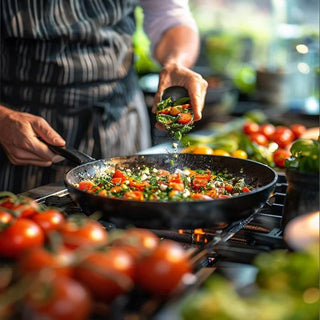Aleppo pepper is a flavorful and mildly spicy chili pepper originating from the Middle East, specifically around the Syrian city of Aleppo. This deep red, crushed pepper is widely used in Middle Eastern and Mediterranean cuisines to add a balanced heat and a rich, fruity depth to dishes. Its unique taste, versatility, and moderate spice level have gained popularity worldwide.
Origins and History
Aleppo pepper, also known as Halaby pepper, is named after the historic city of Aleppo in Syria, a region known for its rich culinary heritage. This spice has been a staple in Middle Eastern cuisine for centuries, used in everything from kebabs and stews to salads and spice blends. Due to ongoing conflicts in Syria, much of the Aleppo pepper's commercial production has moved to neighboring countries like Turkey.
Flavor Profile
Aleppo pepper is often compared to other chili flakes, such as red pepper flakes or paprika, but it has distinct characteristics that set it apart:
-
Mild to moderate heat: It has a Scoville Heat Unit (SHU) rating of around 10,000—less spicy than cayenne pepper but hotter than paprika.
-
Fruity and tangy notes: Aleppo pepper has a slight sweetness similar to sun-dried tomatoes.
-
Slight smokiness: Unlike fiery peppers, it has a smoky and earthy undertone.
-
Oily texture: The flakes have a slightly moist, oily consistency due to the pepper's natural oils, which enhance their flavor.
How is Aleppo Pepper Made?
The traditional process of making Aleppo pepper includes the following:
-
Harvesting – The chili peppers are picked when they ripen to a deep red color.
-
Sun-drying – The peppers are dried in the sun to concentrate their flavor.
-
De-seeding – The seeds are removed to reduce excessive bitterness.
-
Grinding – The dried peppers are crushed into coarse flakes, often mixed with a small amount of salt to preserve their freshness.
Uses in Cooking
Aleppo pepper is a versatile spice that can be used in various dishes. Here are some popular ways to incorporate it into your cooking:
1. Seasoning Meats & Grilled Foods
-
Sprinkle on lamb, chicken, or beef before grilling.
-
Use it in spice rubs for kebabs or roasted meats.
2. Enhancing Sauces & Marinades
-
Add to pasta sauces, dressings, and dips like hummus.
-
Mix into olive oil for a simple but flavorful drizzle.
3. Topping for Eggs & Vegetables
-
Sprinkle over scrambled eggs, roasted potatoes, or avocado toast.
-
Mix into salads and grain bowls for a mild heat.
4. Baking & Fusion Dishes
-
Some bakers use Aleppo pepper in chocolates or honey-based desserts for a sweet-spicy contrast.
-
It can also be added to homemade bread or crackers for a unique twist.
Health Benefits of Aleppo Pepper
Like many chili peppers, Aleppo pepper has several health benefits:
-
Rich in Antioxidants – Contains vitamins A and C, which help boost immunity.
-
Aids Digestion – Capsaicin, which gives chili peppers their heat, can support metabolism and gut health.
-
Anti-inflammatory Properties – This may help reduce inflammation and pain.
Substitutes for Aleppo Pepper
If you don’t have Aleppo pepper on hand, several substitutes can provide a similar flavor and heat level:
1. Paprika + Cayenne Pepper
-
Ratio: 3 parts smoked or sweet paprika + 1 part cayenne pepper
-
Why it works: Paprika adds the smoky, earthy flavor, while cayenne provides the heat.
2. Ancho Chili Powder
-
Ratio: Use 1:1 as a replacement for Aleppo pepper.
-
Why it works: Ancho chili powder has a mild heat and fruity undertones similar to Aleppo pepper.
3. Crushed Red Pepper Flakes + Lemon Zest
-
Ratio: 2 parts red pepper flakes + 1 part lemon zest
-
Why it works: Red pepper flakes offer heat, and the lemon zest mimics the subtle tanginess of Aleppo pepper.
How to Store Aleppo Pepper
To maintain its freshness and potency, Aleppo pepper should be stored properly:
-
Keep it in an airtight container – Exposure to air can cause the spice to lose its aroma and flavor over time.
-
Store in a cool, dark place – Heat and light can degrade its natural oils.
-
Refrigeration (optional) – If you live in a hot or humid climate, storing Aleppo pepper in the fridge can help extend its shelf life.
Properly stored Aleppo pepper can last up to a year without significant loss of flavor.
Regional Dishes Featuring Aleppo Pepper
Aleppo pepper is widely used in Middle Eastern, Mediterranean, and Turkish cuisines. Here are a few dishes where it shines:
1. Muhammara (Red Pepper & Walnut Dip)
-
A delicious Syrian dip made with roasted red peppers, walnuts, garlic, and Aleppo pepper.
-
Often served with pita bread or as a spread for sandwiches.
2. Lahmacun (Turkish Pizza)
-
A thin, crispy flatbread topped with spiced minced meat, onions, and Aleppo pepper.
-
Served with lemon wedges and fresh herbs.
3. Shakshuka
-
A North African and Middle Eastern dish featuring poached eggs in a spiced tomato sauce.
-
Aleppo pepper adds a mild heat and enhances the flavor of the tomatoes.
4. Kebab Marinades
-
Aleppo pepper is used in spice rubs and marinades for lamb, chicken, and beef.
-
It pairs well with cumin, coriander, garlic, and olive oil.
Aleppo Pepper in Modern Cooking
While Aleppo pepper has traditional roots, chefs and home cooks are using it in creative, modern ways:
-
Cocktails – Added to margaritas or Bloody Marys for a smoky kick.
-
Popcorn Seasoning – Mixed with butter and salt for a gourmet popcorn flavor.
-
Chocolate Desserts – Used in brownies, truffles, or hot chocolate for a sweet-spicy combination.
-
Pasta & Pizza Toppings – Sprinkled over spaghetti, ravioli, or pizza for extra depth.
Final Thoughts
Aleppo pepper is more than just a spice—it’s a cultural and culinary gem with deep roots in Middle Eastern cuisine. Its balanced heat, fruity undertones, and slight smokiness make it a versatile ingredient in traditional and modern dishes. Whether preparing a classic Muhammara dip, seasoning grilled meats, or experimenting with fusion cuisine, Aleppo pepper adds a unique depth of flavor that enhances any dish.
If you haven’t tried it yet, consider adding Aleppo pepper to your spice rack—it might just become your new favorite seasoning!
FAQs
1. What is Aleppo Pepper Used For?
Aleppo pepper is commonly used to season meats, kebabs, stews, and dips like hummus and Muhammara. It adds a mild, fruity heat to dishes and can be sprinkled over eggs, roasted vegetables, pasta, and even pizza for extra flavor.
2. How Spicy is Aleppo Pepper Compared to Other Peppers?
Aleppo pepper has a moderate heat level of around 10,000 Scoville Heat Units (SHU), making it milder than cayenne pepper but slightly hotter than paprika. Its heat builds slowly, offering warmth without an overpowering burn, making it ideal for those who enjoy a balanced spice.
3. What is a Good Substitute for Aleppo Pepper?
If you can’t find Aleppo pepper, you can replicate its mild heat and smoky flavor by mixing smoked paprika and cayenne pepper (3:1 ratio). Another option is Ancho chili powder, which shares its fruity undertones but is slightly less spicy.
4. Where Can I Buy Aleppo Pepper?
Aleppo pepper is available in Middle Eastern grocery stores, specialty spice shops, and online retailers. Due to supply issues from Syria, much of today’s Aleppo pepper comes from Turkey, but it still retains the same rich, aromatic qualities.
5. How Should Aleppo Pepper Be Stored?
Store Aleppo pepper in an airtight container in a cool, dark place to preserve its flavor and freshness. Its natural oils can go rancid over time, so refrigeration can help extend its shelf life for up to a year.


